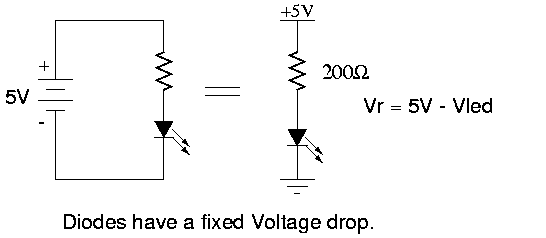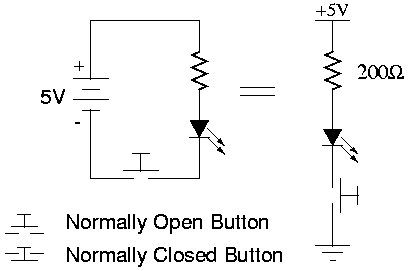Difference between revisions of "Introduction to Electronics"
m (→Current, Voltage, Resistance) |
(→Current, Voltage, Resistance) |
||
| Line 13: | Line 13: | ||
A common analogy may be used to relate these three quantities to water flow in pipes in place of electrons in wires. Imagine you have two water tanks connected from the bottoms by a pipe (such as the drain of a double sink). If one tank is full of water and the other one nearly empty we know intuitively that the water in the full tank will flow through the pipe into the nearly empty tank. | A common analogy may be used to relate these three quantities to water flow in pipes in place of electrons in wires. Imagine you have two water tanks connected from the bottoms by a pipe (such as the drain of a double sink). If one tank is full of water and the other one nearly empty we know intuitively that the water in the full tank will flow through the pipe into the nearly empty tank. | ||
| − | + | [[Image:Water_simple.jpg]] | |
| + | The water in the full tank near the drain pipe is under pressure caused by gravity acting on the water above it in the tank. The difference in pressure between the water at the bottom of the full tank and the bottom of the only slightly full tank is analogous to the voltage V between poles of a battery. Recall that voltage is always measured with respect to two distinct point in a circuit. In the case of a battery there is an excess of electrons present at the negative pole which are attracted to the electron holes at the positive pole with a potential or voltage determined by the chemical and physical properties of the battery. | ||
| + | [[Image:Water.jpg]] | ||
| − | + | Current I is analogous to the quantity of water flowing through a pipe at a given moment in time. Actually for the analogy to hold rigorously, the pipe needs to be filled with some sort of material like cotton or batting that resists the flow of water. | |
| − | Q: | + | Q: Would the voltage be different if we made the full tank taller and skinnier? |
| − | Q: | + | Q: Would the voltage change if we increased the amount of water in the full tank? |
| − | So what governs the | + | Q: What happens if we open the pipe between the two tanks and let water flow? |
| + | |||
| + | So what governs the flow rate I right after the pipe is opened? The diameter of the pipe. The larger the pipe the less resistance there is to the water flow (or current I). Placing a resistor in an electric circuit has the same effect as reducing the water pipe's cross-sectional area. The amount of flow I is not fixed, but given the same water pressure V (or Voltage), the smaller the constriction the less flow occurs. Increasing the water pressure can counteract the reduction in flow. You can think of a battery as a pair of tanks, one full extra electrons and one empty to which extra electrons are attracted. (does adding constrictions hold in water as for electricity?) .... '''Ohm's Law''' ... | ||
==Ohm's Law== | ==Ohm's Law== | ||
Revision as of 06:12, 23 June 2008
Electrical Network
An interconnection of electrical elements that contains a closed loop is an electrical circuit. The closed loop allows electrons to flow through the electrical elements. We now explain how to analyze simple electrical circuits in terms of voltage, current, and resistance.
Current, Voltage, Resistance
Current describes the quantity of electrons passing through a point in a circuit at a given instant in time. Current is measured in Amperes (Amps, A).
Voltage describes the potential difference in electrical charge between two points in an electrical circuit. Voltage (also known as electric potential) is measured in Volts (V).
Resistance (a special case of Impedance) describes the capacity of a circuit element to resist or impede the flow of electrons in the circuit. Resistance in measured in Ohms.
A common analogy may be used to relate these three quantities to water flow in pipes in place of electrons in wires. Imagine you have two water tanks connected from the bottoms by a pipe (such as the drain of a double sink). If one tank is full of water and the other one nearly empty we know intuitively that the water in the full tank will flow through the pipe into the nearly empty tank.
The water in the full tank near the drain pipe is under pressure caused by gravity acting on the water above it in the tank. The difference in pressure between the water at the bottom of the full tank and the bottom of the only slightly full tank is analogous to the voltage V between poles of a battery. Recall that voltage is always measured with respect to two distinct point in a circuit. In the case of a battery there is an excess of electrons present at the negative pole which are attracted to the electron holes at the positive pole with a potential or voltage determined by the chemical and physical properties of the battery.
Current I is analogous to the quantity of water flowing through a pipe at a given moment in time. Actually for the analogy to hold rigorously, the pipe needs to be filled with some sort of material like cotton or batting that resists the flow of water.
Q: Would the voltage be different if we made the full tank taller and skinnier?
Q: Would the voltage change if we increased the amount of water in the full tank?
Q: What happens if we open the pipe between the two tanks and let water flow?
So what governs the flow rate I right after the pipe is opened? The diameter of the pipe. The larger the pipe the less resistance there is to the water flow (or current I). Placing a resistor in an electric circuit has the same effect as reducing the water pipe's cross-sectional area. The amount of flow I is not fixed, but given the same water pressure V (or Voltage), the smaller the constriction the less flow occurs. Increasing the water pressure can counteract the reduction in flow. You can think of a battery as a pair of tanks, one full extra electrons and one empty to which extra electrons are attracted. (does adding constrictions hold in water as for electricity?) .... Ohm's Law ...
Ohm's Law
V = IR Ohm's Law states that Voltage = Current x Resistance or V = IR. The equation can be rearranged to find any one of the three quantities given the other two.
Consider the following circuit:
The voltage in the circuit is given (10V from the battery) and the resistance is also given as the 100 ohm resistor is the only resistive element in the circuit. So we can compute the current in the circuit as: I = V/R = 10V / 100 Ohms = 0.1 Amps or 100 milli-Amps.
Button LED Example
The following circuit diagram show the most basic LED (Light Emitting Diode) circuit:
Diodes are from the family of semiconductors. Unlike a resistors, diodes always have a fixed voltage drop in a circuit. A diode passes current in only one direction, a very useful property for protecting circuits from incorrect current flow. The arrow in the diode symbol points in the direction that current flows, so normally you would place a diode in your circuit with the arrow pointing to a ground. Therefore once we know the current passing through the resistor in this circuit we also know the current passing through the LED. The brightness of an LED is proportional to the amount of current passing through it. How would you make the LED shine brighter? less brightly?
Now consider the following circuit which adds a button:
The button simply interrupts or re-connects the flow of current through the circuit lighting or extinguishing the LED in the process.


